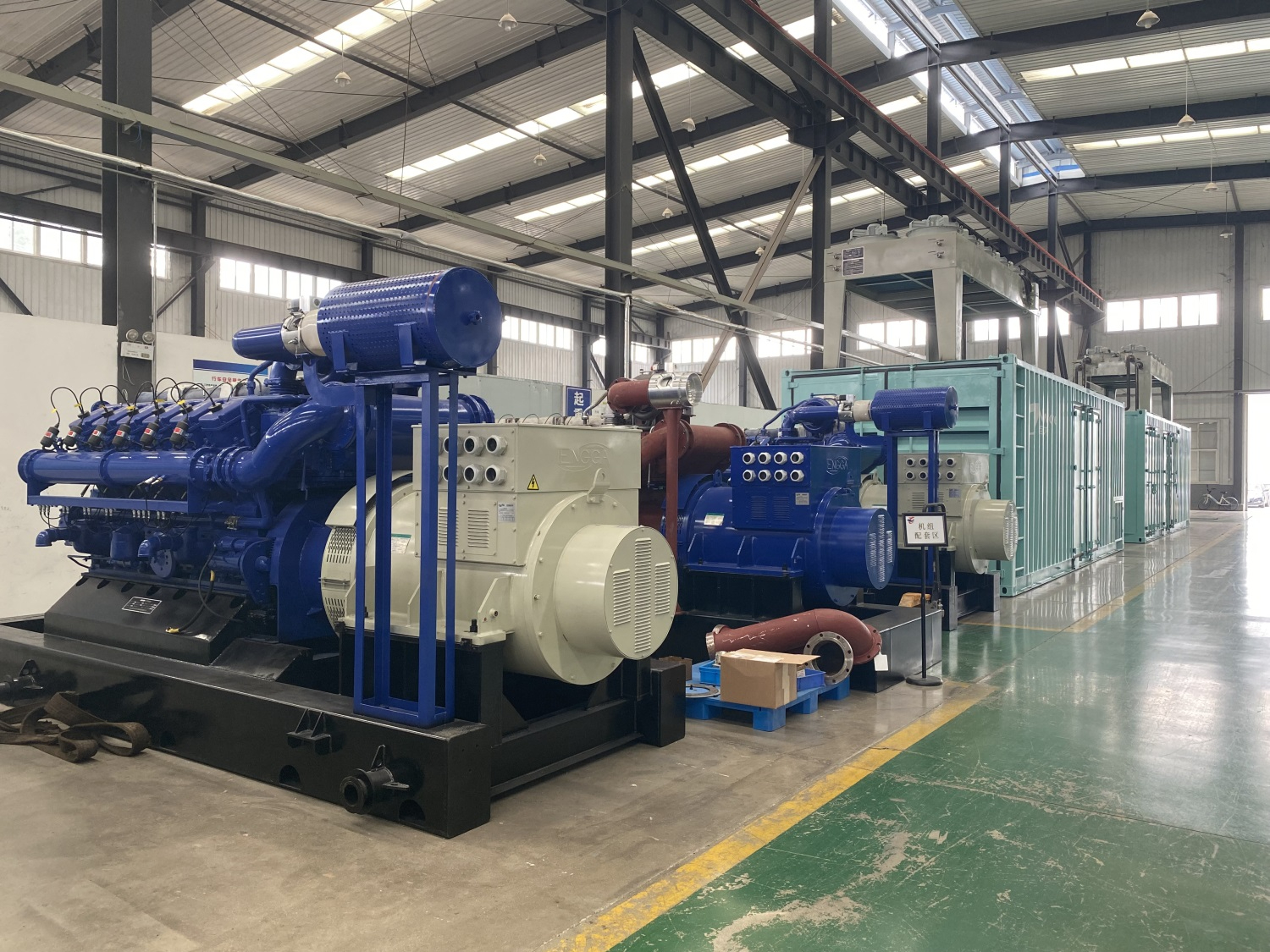 聯(lián)系 - 熱線
聯(lián)系 - 熱線

 聯(lián)系 - 熱線
聯(lián)系 - 熱線
帶你了解瓦斯發(fā)電機(jī)組工作效率
瓦斯發(fā)電機(jī)組作為一種將瓦斯氣體轉(zhuǎn)化為電能的高效能源利用設(shè)備,其工作效率的提升依賴于多環(huán)節(jié)的技術(shù)協(xié)同優(yōu)化。從燃料利用角度,機(jī)組采用預(yù)混燃燒技術(shù),通過(guò)精確控制瓦斯與空氣的混合比例,實(shí)現(xiàn)完全燃燒,使熱能轉(zhuǎn)化效率提升至35%以上,較傳統(tǒng)擴(kuò)散燃燒方式提高10%-15%。同時(shí),燃?xì)庠鰤合到y(tǒng)確保低濃度瓦斯穩(wěn)定輸送,突破了傳統(tǒng)設(shè)備對(duì)甲烷濃度不低于30%的限制,使煤礦乏風(fēng)、沼氣等低熱值燃料得以高效利用。
As an efficient energy utilization equipment that converts gas into electrical energy, the improvement of the working efficiency of gas generator units relies on the coordinated optimization of multiple technological links. From the perspective of fuel utilization, the unit adopts premixed combustion technology, which achieves complete combustion by precisely controlling the mixing ratio of gas and air, and improves the thermal energy conversion efficiency to over 35%, which is 10% -15% higher than traditional diffusion combustion methods. At the same time, the gas boosting system ensures stable transportation of low concentration gas, breaking through the traditional equipment's limit of methane concentration not less than 30%, enabling efficient utilization of low calorific value fuels such as coal mine exhaust and biogas.
在熱能管理層面,機(jī)組配備高效余熱回收裝置,通過(guò)缸套水換熱器、煙氣熱交換器將排放廢熱轉(zhuǎn)化為蒸汽或熱水,綜合能源利用率可達(dá)85%。以某型1MW機(jī)組為例,其發(fā)電同時(shí)可滿足6000平方米建筑的供暖需求,實(shí)現(xiàn)能源梯級(jí)利用。此外,智能冷卻系統(tǒng)根據(jù)負(fù)荷動(dòng)態(tài)調(diào)節(jié)循環(huán)水量,避免過(guò)度能耗,進(jìn)一步降低熱損耗。
At the level of thermal energy management, the unit is equipped with an efficient waste heat recovery device, which converts the discharged waste heat into steam or hot water through cylinder liner water heat exchangers and flue gas heat exchangers, with a comprehensive energy utilization rate of up to 85%. Taking a certain type of 1MW unit as an example, its power generation can simultaneously meet the heating needs of a 6000 square meter building, achieving energy cascade utilization. In addition, the intelligent cooling system dynamically adjusts the circulating water volume according to the load, avoiding excessive energy consumption and further reducing heat loss.
機(jī)械結(jié)構(gòu)設(shè)計(jì)方面,采用稀薄燃燒室與陶瓷耐磨涂層技術(shù),使燃燒室壁面溫度降低,減少熱輻射損失,同時(shí)延長(zhǎng)關(guān)鍵部件使用壽命。高精度加工的活塞環(huán)與缸套配合間隙控制在0.03mm以內(nèi),降低摩擦功耗,機(jī)械效率提升至92%。部分機(jī)型引入可變幾何渦輪增壓器,通過(guò)實(shí)時(shí)調(diào)整渦輪流通截面積,使不同工況下進(jìn)氣壓力保持最優(yōu),提升低負(fù)荷時(shí)段效率。
In terms of mechanical structure design, lean combustion chamber and ceramic wear-resistant coating technology are adopted to reduce the wall temperature of the combustion chamber, minimize thermal radiation loss, and extend the service life of key components. The clearance between the high-precision machined piston ring and cylinder liner is controlled within 0.03mm, reducing friction power consumption and increasing mechanical efficiency to 92%. Some models introduce variable geometry turbochargers, which adjust the turbine flow cross-sectional area in real-time to maintain optimal intake pressure under different operating conditions and improve efficiency during low load periods.

電氣控制系統(tǒng)是效率優(yōu)化的核心。全數(shù)字化電控單元實(shí)時(shí)監(jiān)測(cè)缸內(nèi)壓力、爆震傾向等20余項(xiàng)參數(shù),以毫秒級(jí)響應(yīng)速度調(diào)整點(diǎn)火提前角、噴氣脈寬,確保始終工作在最佳熱效率區(qū)間。當(dāng)負(fù)荷率低于40%時(shí),系統(tǒng)自動(dòng)切換為部分負(fù)荷模式,通過(guò)關(guān)閉冗余氣缸維持高效運(yùn)行,避免“大馬拉小車”現(xiàn)象。
The electrical control system is the core of efficiency optimization. The fully digital electronic control unit monitors more than 20 parameters such as cylinder pressure and detonation tendency in real time, and adjusts the ignition advance angle and jet pulse width with millisecond response speed to ensure that it always operates in the optimal thermal efficiency range. When the load rate is below 40%, the system automatically switches to partial load mode, maintaining efficient operation by shutting down redundant cylinders to avoid the phenomenon of "big horses pulling small cars".
運(yùn)維管理同樣關(guān)鍵。在線監(jiān)測(cè)系統(tǒng)持續(xù)跟蹤排氣溫度、振動(dòng)幅值等指標(biāo),結(jié)合大數(shù)據(jù)模型預(yù)測(cè)維護(hù)節(jié)點(diǎn),使設(shè)備始終處于健康狀態(tài)。據(jù)實(shí)測(cè)數(shù)據(jù),科學(xué)維護(hù)可使機(jī)組效率衰減率控制在0.5%/年以內(nèi),遠(yuǎn)低于行業(yè)平均水平。
Operations management is equally crucial. The online monitoring system continuously tracks indicators such as exhaust temperature and vibration amplitude, and combines big data models to predict maintenance nodes, ensuring that the equipment is always in a healthy state. According to actual measurement data, scientific maintenance can control the efficiency degradation rate of the unit within 0.5% per year, far below the industry average level.
通過(guò)燃料適配、熱能回收、機(jī)械優(yōu)化與智能控制的綜合創(chuàng)新,現(xiàn)代瓦斯發(fā)電機(jī)組實(shí)現(xiàn)了能源轉(zhuǎn)化效率與運(yùn)行穩(wěn)定性的雙重突破,為瓦斯資源化利用提供了高效解決方案。
Through comprehensive innovation in fuel adaptation, heat recovery, mechanical optimization, and intelligent control, modern gas generators have achieved a dual breakthrough in energy conversion efficiency and operational stability, providing efficient solutions for gas resource utilization.
本文由瓦斯發(fā)電機(jī)組友情奉獻(xiàn).更多有關(guān)的知識(shí)請(qǐng)點(diǎn)擊:http://www.asianelephant.cn我們將會(huì)對(duì)您提出的疑問(wèn)進(jìn)行詳細(xì)的解答,歡迎您登錄網(wǎng)站留言.
This article is a friendly contribution from the analysis of gas generator sets For more information, please click: http://www.asianelephant.cn We will provide detailed answers to your questions. You are welcome to log in to our website and leave a message
業(yè)務(wù)分類
Business classification產(chǎn)品推薦
product recommendation聯(lián)系方式
Contact Information
聯(lián)系我們
contact us
 公司地址:山東省濟(jì)南市章丘區(qū)龍山街道潘王路24239號(hào)(龍山工業(yè)園八號(hào)路)
公司地址:山東省濟(jì)南市章丘區(qū)龍山街道潘王路24239號(hào)(龍山工業(yè)園八號(hào)路)
關(guān)注公眾號(hào)

企業(yè)二維碼

截屏,微信識(shí)別二維碼